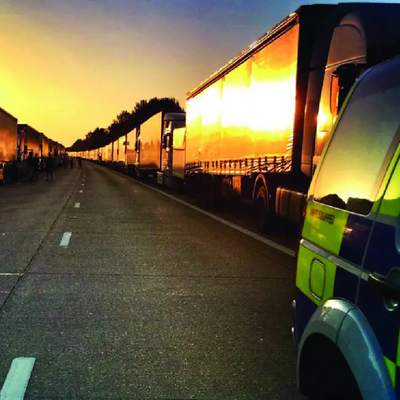Live Test of New Operation Brock Barrier Deployment on M20 [Spoiler: Contains Motorway Closures in December]

Plans to keep traffic moving in Kent in the event of cross-Channel disruption will undergo a live test next week.
Highways England and its partners in the Kent Resilience Forum will carry out a live test to mobilise a moveable barrier system on a section of the M20 from Friday 11 December. It will mean that parts of the motorway are closed between Maidstone and Ashford for four nights, with signed diversions in place.
The barrier will be used to create a new layout with a contraflow system. Once deployed, this will allow traffic to continue travelling in both directions on the motorway at the same time as port bound HGVs are queued, if necessary, on the coastbound carriageway until they can travel through to the Port of Dover or Eurotunnel.
The barrier is part of Operation Brock, a series of measures aimed at keeping the M20 open in both directions during periods of cross-Channel disruption. During the test the barrier will be installed and then removed.
It is much quicker to deploy than previous systems which took weeks to install and remove, and allows more traffic to continue using the motorway, off local roads. It plays a key part in managing any disruption at the ports after the EU exit date, 31 December 2020.
To ensure that Highways England and its Kent Resilience Forum partners are ready to manage any disruption at the ports after the EU exit date, Operation Brock needs to be active by 31 December 2020. The live test is being used to review each stage of the deployment and removal of the barrier and the other traffic management needed for Operation Brock.
To make sure the barrier is deployed and removed safely, the M20 will be closed coastbound between junction 7 (for Maidstone) and junction 9 (Ashford), and London-bound between junctions 9 and 8 (Maidstone East), overnight (8pm to 8am) on Friday 11, Saturday 12, Sunday 13, and Monday 14 December, returning to normal operation by 8am on Tuesday 15 December. Whenever the M20 is closed, signed diversions will be in place.
At the end of the test the barrier will be returned to the London-bound hard shoulder.
What will the M20 look like during the trial?
- The M20 will close in both directions overnight between junctions 7 and 9 (coastbound) and junctions 9 and 8 (London-bound) on Friday 11 December for the installation of the moveable barrier.
- When the M20 reopens by 8am on Saturday 12 December, the contraflow will be in place in its initial phase. Drivers will need to follow the different layout on the M20 from just north of Junction 8 (for Hollingbourne/Leeds) to Junction 9 (Ashford). Lorries heading for mainland Europe will be routed down the coastbound carriageway, with a 30mph speed limit in place. All other traffic will be directed onto the contraflow, with two lanes in each direction operating at 50mph.
- The M20 will close in both directions overnight between junctions 7 and 9 (coastbound) and junctions 9 and 8 (London-bound) at 8pm on Saturday 12 December and reopen by 8am on Sunday 13 December with the contraflow now open in its final phase.
- The M20 will again close overnight between junctions 7 and 9 (coastbound) and junctions 9 and 8 (London-bound) at 8pm on Sunday 13 December for removal of traffic management on the coastbound carriageway.
- When the M20 reopens by 8am on Monday 14 December, the coastbound carriageway will be back to normal, with all traffic management removed. The London-bound carriageway will be open but some traffic management - including the moveable barrier - will still be in place. Speed restrictions will apply. The London-bound carriageway will be closed overnight between junctions 9 and 8 at 8pm on Monday 14 December with the moveable barrier being moved to the far side of the hard shoulder.
- The London-bound M20 will reopen by 8am on Tuesday 15 December, with the M20 back to its normal layout in both directions, with three lanes operating at the national speed limit.
About Operation Brock
Operation Brock is a series of measures which crucially keeps the M20 open in both directions using a contraflow system. As with previous deployments in 2019, Operation Brock has stages that can be deployed sequentially, scaling up or down to meet demand.
When Operation Brock is in force it is a legal requirement to use the signed routes only for HGV journeys to Port of Dover and Eurotunnel.
Depending on the scale of disruption, and whether HGVs are travelling to Port of Dover or Eurotunnel, they will be directed to a holding site.
Failure to comply with instructions may result in fines and further delays.
Kent Police take decisions on when to use the different phases of the system. Options include:
- A20 Dover TAP: A queuing system which holds lorries until space becomes available at the Port.
- M20 Moveable Barrier: A concrete barrier than can be deployed quickly between junctions 8 and 9 of the M20 to install a contraflow. HGVs bound for Dover and/or Eurotunnel will be held on the coastbound carriageway.
- Manston Airfield: an off-road site designed to hold traffic heading for the Port of Dover. Border readiness checks will take place here to ensure hauliers have the correct paperwork.
- Ashford Sevington Inland Border Facility: an off-road site next to junction 10A of the M20, likely to be used if the M20 contraflow approaches capacity.
For more information on Operation Brock and other contingency measures in Kent, visit:
How Operation Brock will affect your journey
https://highwaysengland.co.uk/our-work/south-east/m20-junction-8-to-9-moveable-barrier/
Government advice for car drivers in Europe after Brexit
https://www.gov.uk/driving-abroad
Government advice for bus and coach drivers in Europe after Brexit
https://www.gov.uk/guidance/driving-in-the-eu-from-1-january-2021-bus-and-coach-drivers
Government advice for HGV drivers in Europe after Brexit
https://www.gov.uk/transition-haulage
How Kent County Council has prepared for Brexit

Sign up
for email updates


